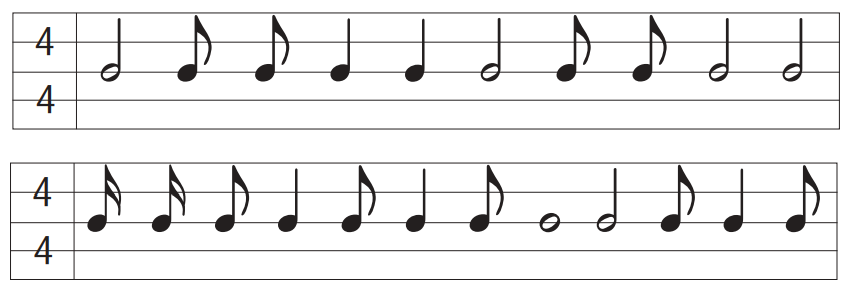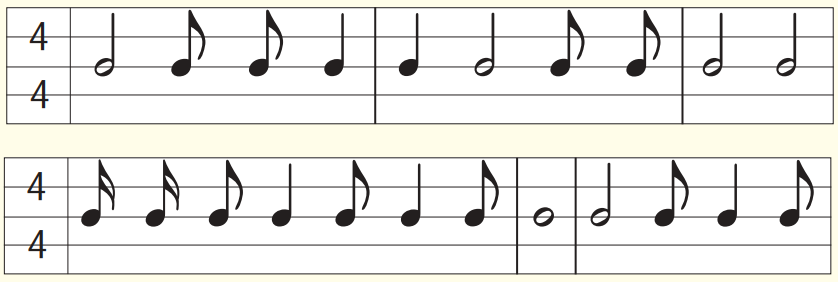Mathematics
Grade Levels: 4th Grade, 5th Grade, 6th Grade,
Topics: AlgebraRatios
Common Core State Standard: 4.NF.4c, 7.RP.3,
Download the Teacher Guide PDF
Lesson:
Background:
It goes almost without saying that writing and playing music is a highly creative skill. What is easy to overlook in the midst of the glamour and publicity of the recording industry is that musicianship is also a highly technical ability.
Printed music uses special symbols to describe when sounds should be made, how long the sounds should last, and how loud they should be. The language of music relies on an agreed-upon set of numerical values for these
symbols, which enables one musician to relay musical ideas to another.
Just as written language is expressed in sentences made up of words, written music is expressed in measures made up of notes. The shape of a note indicates its duration in comparison to other notes:

A sixteenth note lasts half as long as an eighth note.
A half note lasts twice as long as a quarter note.
A whole note lasts four times as long as a quarter note.
Etc.
In general, each measure of a particular piece of music should have the same total duration as the previous measure (though a composer may decide to have this change in the middle of a piece). For example, it is common in march music that each measure have the duration of four quarter notes. This does not mean that only quarter notes are used; it means that when you count the durations of each note in a measure, and add them, it adds up to the same duration as four quarter notes:

The 4-4 symbol at the beginning of this sequence is the time signature. It indicates that there are to be the equivalent of four quarter notes in each measure.
Waltz music, on the other hand, usually has a time signature of 3/4, meaning that each measure is to have the equivalent of three quarter notes.

In addition to the time signature of the music, the musician needs to know how fast the music is to be played. This is indicated by the tempo, which states how many quarter notes, or eighth notes, etc. should be played each minute. In 4/4 time, a tempo of “120” means that there should be 120 notes of quarter note duration (or equivalent) each minute.
If you know how many quarter notes are in each measure (time signature), and how many quarter notes should be played each minute, you can work out how many seconds each measure should take. This, in turn, allows you to determine the length of a piece of music.
Curriculum Connections:
Ratios
1. This table gives a range of possible tempos for three pieces of 4/4 music that range in length from 60 measures to 100 measures.
| Length | Tempo (beats per minute) | ||||||
| 60 measures | 60 | 80 | 100 | 120 | 140 | 160 | 180 |
| 80 measures | 240 sec. | ||||||
| 100 measures | |||||||
a) Complete the table by determining the duration of each piece when played at each tempo. Compute the time in seconds and then convert your answers to minutes.
b) Three different combinations of tempo and length result in an identical duration. Locate and circle the three instances.
c) If the tempo of a piece of music is doubled, what happens to the length of time required to play the music?
Project:
To: Apprentices
From: Music Director
Subject: Writing rhythm patterns
We have been hired to write some rhythm patterns for a company’s electronic drum machines. These machines can imitate the sounds of actual drums. One of the things the machine can do is to play a repeating pattern, usually between 2 and 8 measures in length. Please help me complete this job.
1. Examine this sample of the rhythm line for a piece of music written in 4/4 time. Verify that each measure is complete and has all four counts in it. Add or delete notes as necessary to correct any incorrect measures. Remember that measures are separated by bar lines.

2. Place the necessary bar lines on this piece of music to separate the measures into the correct number of beats per measure.

3. Write a pattern of your own with two or more measures.

When you have finished, I would like you to review the quality of your musical work before it is sent to my office. Please trade papers with a co-worker and check each other’s patterns to ensure that each measure is correct for 4/4 time.
4. With a tempo of 80 beats per minute, how long would it take to play your pattern piece?
5. If the tempo were reduced (slowed) by a ratio of 3:2, how long would it take to play the pattern?
Teaching Guidelines: Rhythm Patterns
Math Topics: Fractions, Ratios
1. The first measure has the correct number of beats. The second measure has an extra eighth note. Students must add the value of one quarter note to the last measure. This can be accomplished by adding one quarter
note, two eighth notes, or four sixteenth notes to the measure.
2. The measures would be separated as follows:

3. Answers will vary, but each measure must contain the value of four beats.
4. The music contains 6 measures, each with 4 beats. 6 x 4 = 24 beats. The tempo is 80 beats per minute. Stated as a proportion, 80 beats/60 seconds = 24 beats/n seconds. It will take 18 seconds to play the song.
5. You may need to point out that reducing the tempo increases the amount of time it will take to play the same notes. Therefore, reducing the tempo by a ratio of 3:2 means that for every 2 seconds it took originally, it
now takes 3. Using a proportion, 3/2 = n/18; n = 27 seconds.
